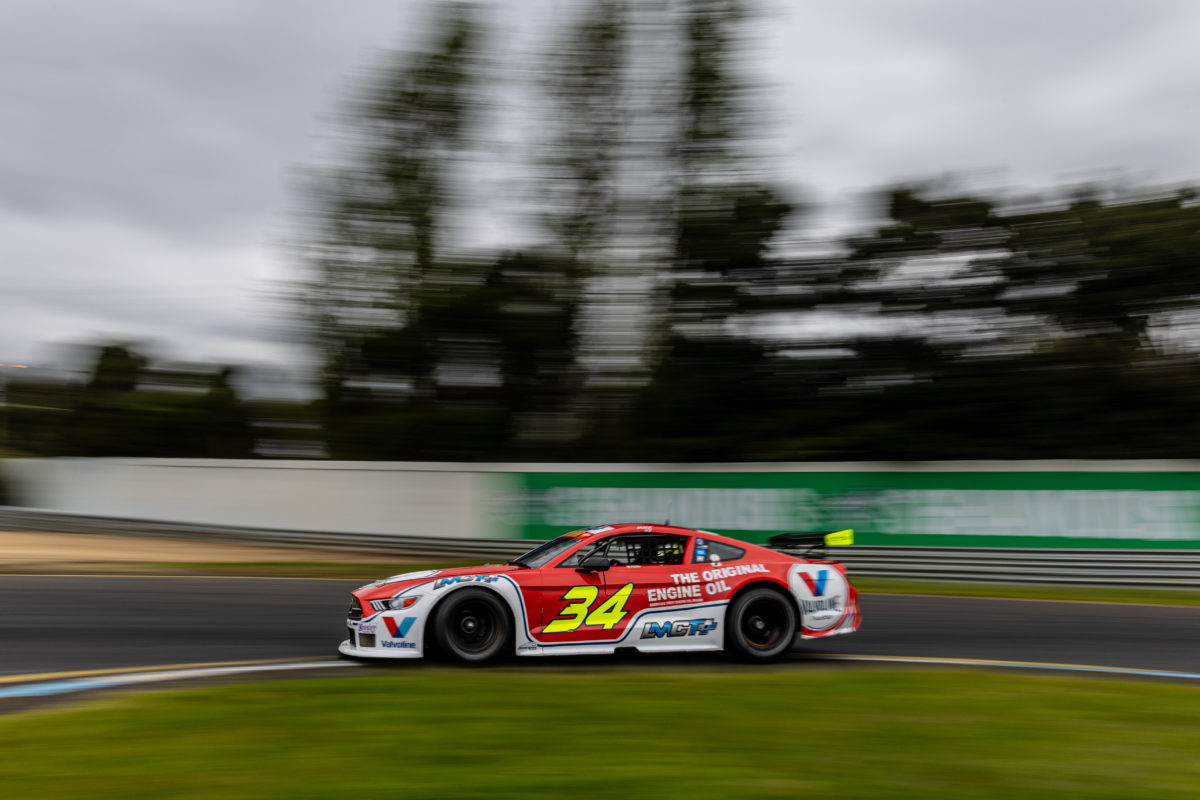

GRM has been found to have raced in breach of the Trans Am Series’ technical regulations, Speedcafe can reveal.
A Motorsport Australia Investigatory Tribunal, of which the official findings and recommendations have been obtained by Speedcafe, has found that Garry Rogers Motorsport cars were in breach for all three races at Winton due to the addition of a then unapproved throttle pedal support plate.
A penalty is yet to be determined, although the usual sanction for a breach of technical regulations is disqualification.
“The Investigatory Tribunal has found that the competitor GRM breached the Trans Am Regulations in each race of round 3 of the series at Winton Motor Raceway, 9-11 June 2023,” the tribunal found.
GRM cars also raced with the unapproved support plate in Rounds 1 and 2 of the season, in February and May respectively, although the finding of a breach only applies to Round 3 due to a statute of limitations.
That much was not found specifically by the Investigatory Tribunal, although it does quote a GRM report written after Round 1 of the season which floats the possibility of such a modification.
Said report reads, in part, “The throttle pedal needs to be, at 0%, further towards the firewall which will allow for the brake and throttle to be more closely matched up once the brake pedal goes long in a long sting.” [sic]
The situation raises questions of fairness to GRM’s rivals, including whether or not the ability to heel-and-toe is performance-enhancing, and also with respect to governance.
On the latter, the Investigatory Tribunal determined that there was a “failing” with respect to communication with competitors because, while GRM worked with the vehicle importer (PBR Distributions) and was open with the relevant Motorsport Australia officials about its modifications, rivals were kept in the dark until after Round 3 of the season.
That point is all the more significant because GRM and the Trans Am Series have substantially common ownership, given GRM Director Barry Rogers holds a 75 percent stake in the Australian Racing Group, which is the official Category Manager, through his Motorsport Events company.
In essence, the series owner was testing modifications in race conditions using its own competing cars.
Notwithstanding that GRM, PBR, Motorsport Australia, and ARG were said to not be “acting other than honestly,” the Investigatory Tribunal also noted:
“Even though the throttle plate was discussed in early February and raced by GRM at Symmons Plains on 24-26 February, another four months passed and three rounds of the Series were completed before other competitors and drivers were alerted. This was a failing and is against the spirit of the Series, one of which’s objectives is to ensure equality of equipment.”
The Investigatory Tribunal also made recommendations with respect to a change of regulations as to how modifications to vehicles may be approved.
As it stands, there remains confusion even today about what power PBR has, as the recognised “Australian manufacturer” of the cars (notwithstanding that it imports the vehicles under licence and manufactures some parts for use in Australian competition(s)), to authorise modifications.
As previously reported, the modifications were said to have been made legal for Round 4 of the season at Queensland Raceway in August because of the technical bulletins pertaining to the support plate and pedal height modifications issued by PBR.
The Investigatory Tribunal, however, determined that “The issue of a PBR bulletin, with or without the consent of Motorsport Australia, does not authorise modification to car.”
Despite that, a ‘race bulletin’ was issued to competitors today, ahead of practice for Round 5 of the season at Sandown, advising, “For the avoidance of doubt, Manufacturer (PBR) Bulletins are considered regulatory for the Trans Am Series.”
In any case, the throttle pedal support plate is now an optional component under the series’ technical regulations.
There remains conjecture as to whether or not the ability to heel-and-toe is performance-enhancing, even after that question was canvassed by the Investigatory Tribunal.
According to GRM’s own post-Round 1 report, “The drivers were generally very happy with the modifications to the pedal box,” and, “They reported that they had no issues with downshifts, axle tramp, rear locking etc across the entirety of the weekend, not typical of what has been seen previously.”
The drivers in question were James Moffat and Lochie Dalton, although GRM would submit to the Investigatory Tribunal that “There is no evidence to suggest that this modification results in a performance advantage” because the latter is exclusively a left-foot braker, a fact accepted by all parties involved in the hearing.
Moffat and Dalton are currently first and second in the series standings, respectively, the former having won two races in Round 1 and the latter having won all three races in Round 3.
Nash Morris, whose father Paul enters his car and was one of the parties to the Investigatory Tribunal hearing, won two races in Round 2 in a non-GRM vehicle.
However, Supercars Championship leader Brodie Kostecki made a written statement to the Investigatory Tribunal which outlined advantages of right-foot braking relative to left-foot braking, the latter of which he had to resort to when he made a cameo in the Trans Am Series last year.
Regular Trans Am driver Elliot Barbour gave oral evidence to the Investigatory Tribunal as to why right-foot braking is his preference.
On the other hand, Motorsport Australia Technical Manager Scott McGrath took the view that the modification was for driver comfort and Category Technical Advisor Cameron Sendall, from PBR, opined that it was not performance-enhancing.
Ultimately, the Investigatory Tribunal did not establish that it is definitely a performance advantage.
What is clear, though, is that GRM had been ‘testing’ modifications to its vehicles in race conditions.
Furthermore, it had been doing so without the knowledge of its rivals, although with the support of Motorsport Australia officialdom and the vehicle importer.
Approached for comment today at Sandown, Barry Rogers told Speedcafe, “It’s still ongoing and hopefully next week that will get sorted out; I’m really not sure as I’ve left that with the Team Manager [Stefan Millard].
“We don’t think we’ve done anything wrong.”
The Investigatory Tribunal is inviting further submissions from those who appeared at the hearing on the question of the penalty for the breach, which will be determined no sooner than September 15.
The Investigatory Tribunal was chaired by Justice Peter Davis, with tribunes Stephen Lisk and Andrew Jones, while Curtis Deboy was the secretary.
Those who were invited to and attended the hearing (the ‘Interested Parties’) were GRM’s Millard, rival competitor Paul Morris, Motorsport Australia Advocate Steven Chopping, McGrath, ARG’s Liam Curkpatrick (as Category Manager), and Sendall.
The controversy is not the first involving GRM and a possible breach of technical rules in the Trans Am Series, with a technical bulletin issued just over 12 months ago to ban the trick of deliberately loose roof struts, which may or may not have produced an aerodynamic advantage.





















Discussion about this post